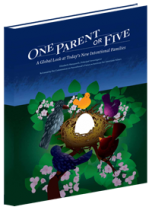What makes one a parent? Biology or intent?

In a cartoon, a kindly woman and a young child are standing in front of six people. The woman is telling the child, “This is your intended mother, this is your intended father, this is your egg donor, this is your sperm donor, this is your surrogate—and this is your psychiatrist to help you sort it all out.”
This cartoon may describe the extreme, but it’s not the only complicated arrangement that children are being asked to grow up in today. In a recent report, One Parent or Five? A Global Look at Today’s New Intentional Families, Elizabeth Marquardt provides a survey of these “new intentional families.”
1. What Is Intentional Parenthood?
2. Meet Today’s Intentional Families
One-Parent Families
Single Mother by Choice
Single Father by Choice
Posthumous Conception
Cloning?
Two-Parent Families
Married Mother and Father
Same-Sex Marriage and Parenting
Co-Parenting Pre-Conception Arrangements
Same-Sex Procreation?
Three-Parent Families
Polyamory
Polygamy
Three-Person Reproduction
Four- and Five-Parent Families
Conceiving Children with Four or Five Legal,
Social, Biological, and/or Gestational Parents
Co-Parenting “Bothies”
3. The Wanted Child
This outline sketches what the report itself provides in greater detail—a social experiment on a massive scale, the results of which will not be known for years to come. Marquardt points out, “Some of these family forms are too new, too rare, or until recently too secret to have been studied closely.”
As a social scientist, Elizabeth Marquardt doesn’t deal with the moral and religious dimensions of these new family structures. She does, however, provide a very positive overview of the benefits of the marriage of a man and a woman, forming a traditional family. Several decades of research indicates that “the fruit this family produces—children—is among the hardiest and healthiest in the world.”
Here’s how she summarizes “what having a married mother and father actually does for children.”
By now, the evidence is substantial. Having a married mother and father is correlated with increased physical and mental health, as well as general life happiness, academic and intellectual performance, behavioral success at school, and graduation from college. These children are also more likely to build successful family relationships when they reach adulthood. Children growing up with married mothers and fathers are less likely to live in poverty and suffer its related problems. They are also less likely to suffer from physical or sexual abuse, abuse drugs or alcohol, become involved in criminal or violent behavior, or engage in early sexual activity and premarital childbearing.
This brief paragraph is full of footnotes that will enable anyone interested to look at the original research for additional details.
In a promotional piece for One Parent or Five?, David Blankenhorn, a colleague of Elizabeth Marquardt’s at The Institute for American Values, lists several of the key questions raised by the new family structures and the technologies that enable their creation:
· What defines a parent? Biology or intent?
· Do mothers and fathers really matter?
· Is intending to have a child a key factor in child well-being, or do other factors, such as the family structure in which a child is raised, matter as well?
· Are children fine with “multiple” parents?
· Do young people miss the absence of their own mothers and fathers in their lives?
· Are polygamy and polyamory healthy or unhealthy for children?
· Is the possibility of human reproductive cloning ethical if it improves the quality of an individual’s way of life?
· Does intended parenthood—the commissioning of children—equate to the commodification of human life?
The cultural tsunami produced by the new family structures raises a host of questions for the Church. What is the church—your church—doing to address these profound issues? For starters, we can all give close attention to the insight provided by One Parent or Five?
Elizabeth Marquardt is editor of FamilyScholars.org, as well as vice president for family studies and director of the Center for Marriage and Families at the Institute for American Values. She is also co-author of a related earlier study, My Daddy’s Name is Donor: A New Study of Young Adults Conceived Through Sperm Donation. Additionally, Marquardt is author of Between Two Worlds: The Inner Lives of Children of Divorce (Crown, 2005) and one of the principal researchers of the national study, Hooking Up, Hanging Out, and Hoping for Mr. Right: College Women on Dating and Mating Today.


 July 31, 2012
July 31, 2012 







Comments are closed.